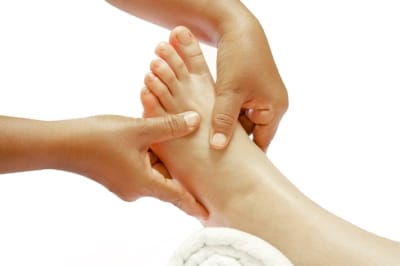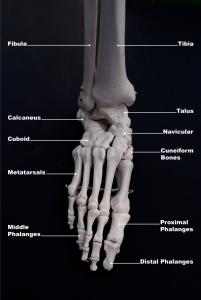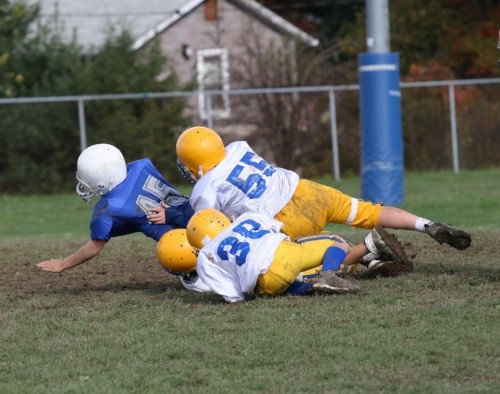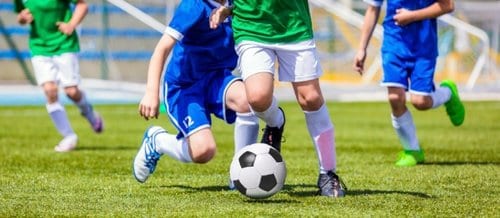Sports Injuries

Anyone can get Sports injuries , they occur across all age groups and all sports. There is no “safe ” sport.
Sports Injuries
While vigorous exercise in the form of sports participation is considered to be a fantastic way to stay in shape, control your stress, and remain socially and emotionally involved in your community, you can expect to experience injuries even from some of the tamer sports activities. One common form of sport, running, is estimated to have 80% of athletes experience an injury each year. While most common foot injuries from running are caused by overworking your body, sudden and drastic changes in your routine can also create problems. Here we listed some common issues you may experience on your daily runs, as well as some useful tips to mitigate your injuries.

Stress Fractures Foot
Stress fractures occur most commonly in women runners with a low BMI. This is called the Triad
Stress fracture
While most associate fractured bones to be a byproduct of a contact sports injury, non-contact sports can also yield similar injuries. Stress fractures are the tiny splintering or cracking of the bone that occur when frequent and mighty forces are inflicted on the limb. If you suffer a stress fracture, recovery will involve extended time off to rest the injured area; you will likely need to use crutches while going to physical therapy. If the fracture is severe enough, surgery may be a necessary option for a full recovery. To avoid a stress fracture, it is best to avoid overuse by training alternative areas of your body, fulfill your body’s calcium needs, and to wear proper footwear.
What is a Hairline Fracture?
Over a period of time you can develop very small cracks on a bone in your lower leg or foot from repetitive pounding activities such as running and jumping. Often they result from sports injuries or overuse. These tiny fractures can also occur in the upper body limbs as a result of falling or hitting into something. Larger fractures or breaks differ in that they are usually the result of one more severe accident or fall, happening suddenly as opposed to gradually. Hairline fractures may heal on their own with adequate rest, they can be painful and linger for weeks. It is not just athletes that get hairline fractures– anyone can get one, especially people who engage in repetitive activities that put stress on your bones.
Symptoms of Hairline Fractures:
- Dull pain that becomes more severe over time
- Light to moderate pressure may be felt
- Pain is reduced with painkillers
Ankle Sprain
Ankle sprain
A sprain is an injury to a muscle when you stretch it past its usual ability to stretch. This usually occurs when your ankle rolls inward or outward; the usual suspects for this are tripping over curbs and potholes, but you could experience a sprain just from landing on your footing incorrectly. The road to recovery will be difficult at first, but we recommend you try some balance exercises. These will help strengthen the muscles around your ankle. Additionally, your doctor will likely recommend you rest the affected area and may have you wear an ankle brace or an air cast.
Basic treatment for a sprained ankle

RICE:
- REST the injured ankle. Use crutches to limit weight bearing.
- Apply ICE to limit excessive swelling.
- Use COMPRESSION wrappings such as ACE bandages to help with swelling and add much needed support.
- ELEVATE the ankle above heart-level when sitting or sleeping. This will help limit swelling and bruising.
How is a sprained ankle treated?
The RICE approach is the first treatment a sprained ankle will receive. This may be all that’s necessary if the sprain is very mild.

Achilles Tendonitis
Achilles tendinitis
Achilles tendinitis is the swelling of the achilles tendon, or rather, the tissues connected to your heel and lower-leg. This kind of foot injury can be caused by wearing improper footwear, failing to stretch before a run (your calves need to be properly warmed up to avoid damage), harder runs, or just by having a naturally flat foot. Try to combat these issues by properly stretching and obtaining quality footwear made specifically for running. Additionally, try to avoid running on steep hills and if you do become injured, take anti-inflammatories and utilize the R.I.C.E. strategy (rest, ice, compression, and elevation). Check in with your doctor or physical therapist for regular updates to make sure you are recovering at a steady pace.
Symptoms of tendon injury (tendinopathy):
- Pain: some degree of pain will almost always accompany a tendon
injury, no matter how minor. This is made worse by activity. - Crepitus: this describes the “crunchy” sensation felt when the affected joint is used. This is often accompanied by discomfort and an audible sound.
- Stiffness: the joint which the tendon crosses usually feels
somewhat stiff when used. - Redness and warmth: the injured joint is often warm to the touch
and can take on a reddish hue. This is a direct result of the chronic
inflammation which is a part of most tendon injuries. - Symptoms vary with time: the above symptoms are usually worse at
night. This is understandable, since the joint has been used throughout the
day. By the same token, symptoms typically become worse with activity.
Stiffness tends to be worse in the morning until the joint begins to “loosen
up.”
Note: the symptoms produced by tendon injuries are often more generalized than arthritis symptoms. With arthritis, symptoms are usually limited to the joint in question. With tendinopathy, symptoms can radiate outwards from the injured joint.
The most commonly affected joints are the shoulders, elbows, and ankles. Tendon injuries of the wrists, hips, and knees occur somewhat less often.
Much of the pain caused by chronic tendon injuries is a direct result of inflammation. In more advanced cases calcium crystals can develop within the tendon, causing further pain. It isn’t known precisely what causes these calcium deposits to form.
Heel Spur
If you experience pain in the bottom of the foot, especially on your first steps in the morning, you may have a heel spur.
Plantar fasciitis
If you are experiencing pain on the sole of your foot, this may be caused by plantar fasciitis (plantar fascia is the tissue on the bottom of your foot). This foot injury can be as mild as slight inflammation or irritation, but may also be severe enough to be a tear in the tissue. Excessive and strenuous pounding of your foot while exercising or wearing footwear such as flip-flops, which are not made to properly distribute the load on your foot, can be the cause of this painful running injury. You may feel a sharp stabbing pain or extreme stiffness in the arch of your foot. To combat this problem, we recommend extra-padded shoes, stretching the heel of your foot by rolling a tennis ball (or similar activities), and that you make sure you are resting the affected area. Additionally, if these fail to remedy the problem, check in with your doctor. They might suggest getting a night splint or custom orthotics, but may also recommend you get a steroid shot to help expedite the healing process (in a healthy way!)
Home Treatment of Plantar Fasciitis

Rest the injured tendon and avoid pain causing activities. Pay attention to your overall health, including sleep, diet, and fitness. Continue to exercise, but only in ways that do not aggravate the injury. If an activity has caused pain, do not resume it until full healing has occurred, which often takes weeks of rest. You may need to change the types of activities you do until full healing is achieved.
Home Remedies
Injury can be prevented, and somewhat relieved, by taking precautions at home, work, and while exercising.
- Use cold compresses: If you notice pain or tenderness in an area, whether in the tendon or muscle surrounding it, cold packs or ice should be applied as soon as possible. Ten to fifteen minutes at a time, up to twice an hour, is recommended for the first 72 hours. After that, continue with 15 to 20 minute applications three times a day until no longer needed for pain. Heating pads may feel nice but will not relieve inflammation the way cold compresses will.
- Use pain relievers: Use NSAID type (ibuprofen or naproxen) or acetaminophen for pain relief. If you have inflammation, NSAIDs will help reduce it, and also are available in cream form for rubbing on sore areas. Be cautious though, not to overuse a joint while the pain is being masked!
- Maintain range of motion: Even though you may be resting a joint, you should still gently move it each day. Strive for full range of motion to prevent stiffness in the joint. As the pain lessons, continue these movements and add
- other exercises that will strengthen the area.
- Resume activity slowly: Resume pre-injury activities at a low level of intensity and increase it gradually. Always warm up and stretch, and stop if you feel pain. Afterward, apply cold compresses.
- Avoid smoking: Healing occurs more slowly in smokers, so avoiding smoking while you are in the healing process is very helpful.
Prevention of Plantar Fasciitis:
- Warm up: Stretching and warm up activities before exercising or playing sports can help prevent injuries, as does stretching afterward.
- Strengthen muscles: Your doctor can discuss specific exercises for strengthening the area involved in your injury. A physical therapist or athletic trainer can also be of help.
- Consider changing activities: If certain activities aggravate your symptoms, think of how you can change them or the way you perform them, to reduce muscle and joint strain. Be aware of repetition of motion, and strive for giving joints and muscles a break. Alternating hands, or changing position of or size of tools can be considered for work activities. For exercise, consider new activities or sports. For example, if you’ve always been a walker or a runner, you could try swimming instead.
- Take action:
- If a certain activity at work seems to be aggravating your condition, speak with your human resources department about possible solutions. Can you perform your tasks in a modified way, or perform other tasks until completely healed?
- If your favored sport or activity is causing the problem, consider whether you are using proper technique. An athletic trainer or an instructor of the sport can help you to see if you are using the correct size and type of equipment for your body. They can also demonstrate proper positioning and motion.
The health of your feet may be taken for granted until they hurt. To receive the right treatment for you, it is important to know where your pain is located.
Heel Pain
Pain in the heel may be plantar fasciitis which is caused by irritation or inflammation of the plantar fascia on the bottom of your feet. It typically produces the most pain in the morning when getting out of bed. It can be felt in the arch or heel of your feet.
To treat it:
- Rest your feet
- Do heel and foot stretches for the surrounding muscles
- Take over-the-counter pain relievers such as NSAIDs
- Wear shoes with good support and a cushioned sole.
Heel spurs are another common source of foot pain. They are caused by abnormal growths of bone in the bottom of the heel. It can occur via abnormal gait or posture, as well as wearing the wrong shoes or running. Spurs can be painful while walking and standing. Most people do not experience pain symptoms with heel spurs. Individuals with flat feet or high arches are more at risk for heel spurs.
To treat heel spurs:
To treat them:
- Wear a cutout heel pad
- Use a custom-made insert (called an orthotic)
- Wear shoes that fit well and have shock-absorbing soles.
- Take over-the-counter pain relievers such as NSAIDs
- Rest
- Physical Therapy
- If you still have pain, ask your doctor about medical procedures.
A stone bruise is identified as a deep bruise of the fat pads of the heels or balls of the feet. This most often occurs from an impactful injury, but may also happen if a hard object is stepped on. The pain has been described like walking on a pebble, and it will gradually subside with time.
In the meantime:
- Rest your foot.
- Ice the area.
- Take over-the-counter pain relievers.
A heel fracture
is usually caused by a high-impact injury such as a fall or car accident. Your heel bone may break or shatter. Heel pain, bruising, swelling, and trouble walking are the most common symptoms of a heel fracture.
To treat it:
- Do not put pressure on the heel. Crutches are recommended
- Protect the heel with pads.
- Wear a splint or cast to protect the heel bone.
- Ask your doctor about over-the-counter or prescription pain relievers such as NSAIDs
- Physical Therapy
- If you’re still in pain, ask your doctor about surgery.
Jones fracture
 A Jones fracture or an avulsion fracture is the break on the fifth metatarsal bone, which is on the pinky toe side of the foot.
A Jones fracture or an avulsion fracture is the break on the fifth metatarsal bone, which is on the pinky toe side of the foot.
Jones fracture symptoms include:
- Tenderness
- Swelling
- Sharp stabbing pain on the outside of the foot
- Discoloration
If you have experienced any of the Jones fracture symptoms above, we suggest you seek out medical advice from a licensed physician. Additionally, if you believe that you may have a broken bone in your foot, you should cease all unnecessary activity and contact your Podiatrist.

Children’s Football Sports Injuries
Pulled muscles
While a strain happens when when a muscle stretches past its operational limit, a pulled muscle is when a muscle is stretched past its breaking point, and tears in the fibers and tendons occur. Like many of the running injuries listed here, overuse can be a contributing factor to a pulled muscle, as well as inflexibility and improper warming-up. Pre-workout stretching and warm-up can help prevent this as the muscle will be properly primed for (mostly) whatever you throw at it. If you do happen to pull a muscle, gently stretch the muscle and cool it down with ice and avoid running for up to five days.
Chafing
If you are like me, with full-figured thighs, then chafing will be something you are quite familiar with. Chafing occurs when skin rubs against skin, and the irritation that follows can be quite…irritating. There are several options to prevent chafing, such as wearing longer running shorts (not just longer, but more form-fitting) or using a body-glide gel.
Children’s Soccer Sports Injuries
Shin splints
One of the most common running injuries you will likely face is the inflammation of the muscles and tendons of the shins, known as shin splints. If you are experiencing pains such as this, icing the affected areas for 15-20 minutes while elevated can help reduce the swelling. To prevent this injury from occurring, researchers suggest that shock-absorbing insoles can help when wearing proper fitting footwear. Also we suggest avoiding harder running surfaces and hills, which can put extra pressure on the shin’s tibialis muscle.
Side stitches
Side stitches aren’t actually stitches (like the ones you might get if you aren’t careful cutting your veggies), and are pains that you can get on the side of your stomach. They used to be called “exercise-related transient abdominal pain (ETAP)”, and they affect almost 70 percent of runners. While its not quite known where this pain comes from, it is highly probable that it is caused by the diaphragm spasming from being overworked. Forming a strong core seems to be the primary way to avoid experiencing a side stitch, and if you think you may be suffering from this, we suggest you try out some core stretches.

